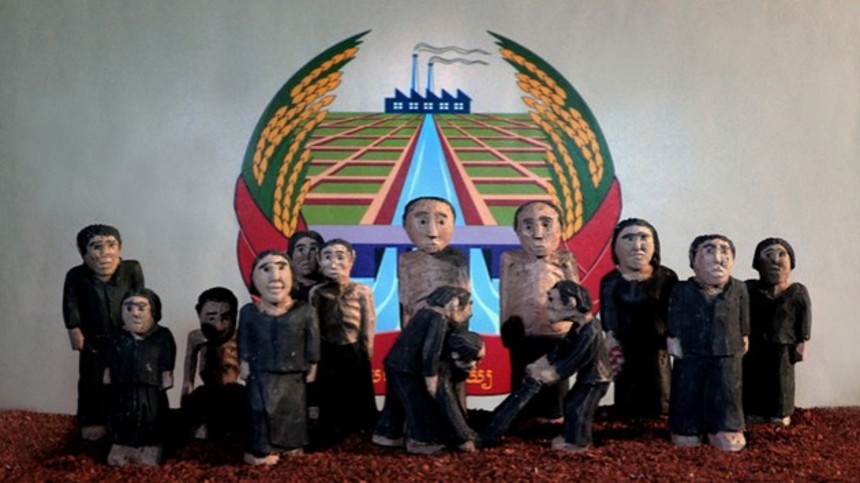Review: THE MISSING PICTURE, A Hauntingly Poetic Work of Emotional and Historical Archaeology

Cambodian filmmaker Rithy Panh has devoted his career to documenting the brutal horrors perpetrated on his homeland by the genocidal Khmer Rouge regime, which for four nightmarish years from 1975 to 1979 subjected the citizens under their control to forced migration from the cities, detention in labor caps and prisons, torture, starvation, and execution.
This resulted in the deaths of around two million people and the near eradication of Cambodian culture and recorded history. Panh, in such powerful documentaries as S-21: The Khmer Rouge Killing Machine (2003) and Duch, Master of the Forges of Hell (2012), tells the story of the victims of the Khmer Rouge and confronts the perpetrators of crimes against humanity.
Rithy Panh's latest film, The Missing Picture, which won the top prize of the Un Certain Regard section at the 2013 Cannes Film Festival, delves into his own story, recalling the loss of his family due to forced labor and starvation, as well as witnessing the deaths of those around him. The title of the film refers to images of an execution that Panh had heard about but was unable to find.
But more broadly than this, there are many "missing pictures" associated with dictator Pol Pot and the Khmer Rouge; for the most part, the only archival footage of the time period that survives is the Khmer Rouge's own propaganda. These pieces of film, excerpted by Panh here and represented by rusted and decaying cans of celluloid that we see being opened, are painted propagandistic fantasy scenarios of the great abundance of the Khmer Rouge's subsistence agrarian economy. In point of fact, as Panh powerfully shows us, this was cruel, state-sponsored illusion, hiding the mass starvation and death that was the true outcome of this socioeconomic engineering. The true experiences of the Cambodian people under these circumstances constitute some of the missing pictures Panh speaks of in this film.
More of these missing pictures concern the rich and vibrant culture that existed before the Khmer Rouge came to power, and which they subsequently nearly destroyed. Panh depicts his family's life before and during the regime in a truly original and unusual fashion. He uses clay figurines - sculpted by Sarith Mang - representing Panh himself, his family, and many others, placed in dioramas to recreate scenes of his childhood home and community, as well as the labor camp that he and his family were sent to. No photographic or archival evidence exists of any of this, so these recreated scenes stand in for the missing documentation of this period.
These clay figures and their environments provide many of the most haunting and poetic images in Panh's film; they evocatively represent childhood in the playful sense of looking like toys children would play with. But these voiceless, immobile figures frozen in time - especially when contrasted with the moving and speaking images included in the film of Pol Pot himself and the propaganda he and the Khmer Rouge created - also represent a moving tribute to the millions eliminated by the regime.
A chillingly calm, detached voiceover (performed by Randal Douc on the French version, and Jean-Baptiste Phou in the English) takes us through the horrors of this period, as well as recalling life before the Khmer Rouge. The striking contrasts of life on either side of this historical dividing line are vividly portrayed here; the exuberant color of Cambodian culture, including music and film, gave way to the privation and drab black uniforms of Pol Pot's regime. This voiceover (scripted by Panh and Christophe Bataille), representing Panh's recollection of both these time periods, dreamily floats above it all, providing a hauntingly poetic atmosphere that transforms these painful memories into often transcendent art.
The term "documentary" proves to be an inadequate description of this extraordinary work. The Missing Picture is a beautifully rendered first-person account of a true-life nightmare that the filmmaker Rithy Panh managed to escape. As he tells us in the film, the "missing picture" actually isn't really missing; it continues to exist inside him, and is the source of images that he can't escape and wishes to be rid of. Panh tells us at the conclusion of his film, "This missing picture, I now hand over to you."
Panh confers upon us as viewers the shared responsibility to carry forward the stories of those no longer with us, so that the memories of these genocidal crimes are never forgotten. With The Missing Picture, a brilliant work of emotional and historical archaeology, Rithy Panh has given us an artistically ideal vehicle with which to achieve this worthy goal.
Review originally published during the New York Film Festival in October 2013. The film opens today at Film Forum in New York City, and on Friday in Los Angeles and Santa Barbara.
The Missing Picture
Director(s)
- Rithy Panh
Writer(s)
- Rithy Panh
- Christophe Bataille (commentary)
Cast
- Randal Douc
- Jean-Baptiste Phou







